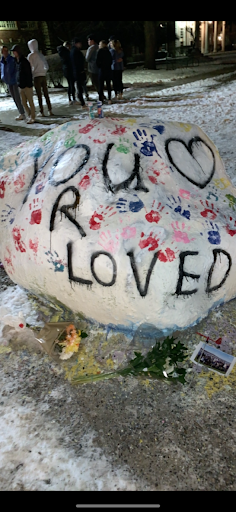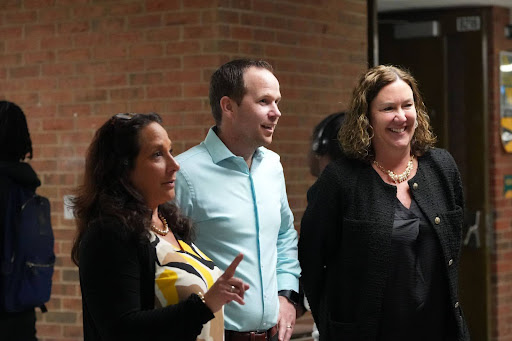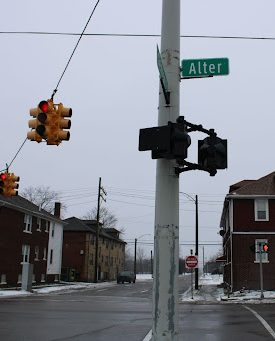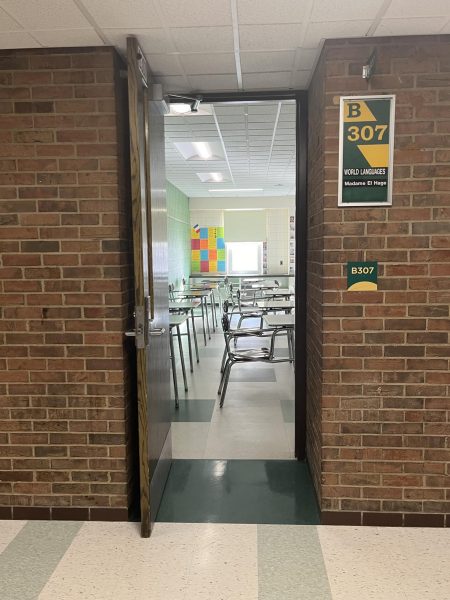Administration unblurs the lines between memorialization and glorification

Photo credit: Courtesy of senior Emme Simpson
After original messages designed to memorialize the death of a North student were dismantled by administration, students from both North and South came together to send a message to the community that “You R Loved.”
April 13, 2020
In the wake of the death of a student, a group of students gave tribute with banners on the North baseball field fence and painting a rock in front of South, generally referred to as “The Rock.”
Soon after the tributes were created, the GPPSS administration had them removed based on district policy and the recommendation of the National Board of Schools Psychologists. While acknowledging the frustration and hurt of students, principal Kate Murray feels this was the safest course of action.
“This type of loss shakes a community and surfaces pain and suffering of all different types. It is crucial that we navigate the situation in a way that keeps the safety of all our students at the forefront of our decision making,” Murray said. “I support the district’s policy and its implementation when they made decisions about the banners and rock. I know that these decisions were difficult to understand.”
The memorials were dismantled due to fear that the memorials could encourage contagion, or suicide clusters. As defined by the Centers for Disease Control and Prevention, suicide clusters are characterized by suicides or suicide attempts that occur closer in time and space than what would be normal for that community.
After dismantling the student memorials, the administration released a district wide email citing research from the National Association of School Psychologists and NASSP to explain why the decision was made. The research suggested that living memorials such as prevention-related material, donations to local crisis centers and participating in events that raise suicide prevention awareness are the best ways to help students cope with emotions and problems. Permanent memorials, on the other hand, were found to be a source of retraumatization and could accentuate or glorify an event.
Although he understands the concerns of administration, senior Johnathan Smith felt the dismantlement of the memorials was inappropriate and overlooked some of the needs of the student body.
“I don’t think the student body’s choice to remember such a friend was glorifying the situation. I don’t think this loss can be glorified in any way,” Smith said. “The best way for us as a community to mourn is together and being open about our feelings.”
According to the Substance Abuse and Mental Health Services Administraion, suicide clusters represent less than five percent of all suicides in young people, however a study has found that the relative risk of suicide in people ages 15 to 19 years old was two to four times higher after exposure to someone else’s suicide. This could be atrributed to young people’s susceptibility to suicide behavior modeling, social norming of suicidal behavior, and imitating suicide methods.
While Smith may have opinions that oppose the administration’s decision to remove the memorials, not all students agree that the administration was wrong. Senior Brett Abke understands both sides of the story.
“The people who are remembering him, they’re not trying to glorify, they’re just trying to remember their friend, which I agree with,” Abke said. “But for the kids who are already at risk, they’re not thinking like us. They’re looking at the attention (the student is) getting and all the positive love (they are) getting, and that’s all they want really.”
Initially, like many other students, Abke felt disrespected by administration for dismantling the memorials. However, he eventually saw how they could have led to the situation being glorified, putting others at risk.
Counselor Kimberly Deptula knows the memory of the student will live on within the walls of North and in the community, but she supports the actions the administration took to ensure the safety of the students
“I think that when we talk about glorifying suicide its important that we instead focus on the positive messages and helping students realize they are loved,” Deptula said. “(We want them to see) there is support for them, there is help for them and those are the kinds of messages we want to spread. There are appropriate ways of honoring and remembering our students, but here at school we need to make sure we are supporting all students.”











